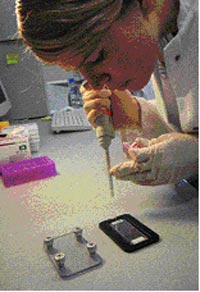Introduction
Tight transcriptional regulation enables the development of multicellular organisms as well as cellular differentiation processes such as hematopoiesis. Networks of accessory transcription factors act upon the basal transcription apparatus and on additional factors that modulate the structure of chromatin. The latter mechanisms elicit epigenetic changes including DNA methylation and histone modifications. Recent developments have highlighted the importance of chromatin modifications for tissue- and cell specific gene expression (Zhang and Reinberg 2001; Wang, An et al. 2003). Histone modifications such as methylation, acetylation, phosphorylation and ubiquitination directly affect chromatin accessibility and thus transcriptional activity of specific genes. The close connection between histone modifications and DNA methylation is highlighted by recruitment of DNA methyltransferases by modified histones and by transcriptional repressors that associate with histone deacetylases and DNA methyltransferases (Jackson, Lindroth et al. 2002; Pradhan and Kim 2002).
While human cancers usually display a high number of genetic changes, acute myeloid leukemia (AML) displays remarkable genomic stability. Indeed, few genetic aberrations are usually found in individual patients. In contrast, epigenetic changes such as DNA methylation and altered histone modifications are frequently encountered in AML blasts (Toyota, Kopecky et al. 2001). Importantly, the aberrant fusion proteins expressed by the typical balanced translocations (e.g. t(8;21) and t(15;17)) specifically alter the chromatin structure of their target genes. AML1-ETO (t(8;21)) and PML-RAR# recruit co-repressor complexes to target gene promoters. PML-RAR# has even been shown to induce aberrant DNA methylation of the RAR#2 target gene (Di Croce, Raker et al. 2002). These findings underline the importance of epigenetic alterations in the pathogenesis of AML. However, so far only few genes have been demonstrated to be actually regulated by chromatin modification in AML. Thus, the identification of the histone code and its alterations in AML will help to further elucidate AML pathogenesis and the regulatory mechanisms leading to oncogenic gene expression patterns.
Our lab is interested in the mechanisms of oncogenic transformation in AML. We have identified and studied target genes of mutant receptor tyrosine kinases and of balanced translocations in AML. We have demonstrated the leukemogenicity of tandem duplication mutations of the Flt3 receptor tyrosine kinase (Mizuki et al. Blood 2000). Recently, we have used microarray analyses to identify gene expression alterations induced by mutant Flt3 (Mizuki et al. Blood 2003). Interestingly, these analyses demonstrated that mutant Flt3 can alter expression levels of various transcription factors including C/EBP# and Pu.1 and thus contribute to the differentiation block in AML. In addition, we have identified target genes of balanced translocations such as AML1-ETO and PML-RAR#. In a collaboration with Dr. S. Hiebert´s group we identified the p14ARF tumor suppressor as an important target gene of AML1-ETO (Linggi, et al. Nat Med 2002). Also, we have identified cyclin A1, an alternative A-type cyclin as a functionally important target gene of PML-RAR# and PLZF-RAR# #(Müller, et al. Blood 2000). Further analyses of cyclin A1 revealed its regulation not only by myeloid transcription factors but also by DNA methylation and histone modifications (Müller et al. MCB 2000). This work also resulted in development of a novel and rapid method to quantitate gene specific DNA methylation in vivo (Müller-Tidow et al., FEBS Lett 2001). We also performed microarray analyses to elucidate shared target genes of several fusion proteins (AML1-ETO, PML-RAR# and PLZF-RAR#) in AML (Müller-Tidow et al., MCB 2004). These analyses identified about 60 shared target genes, several of those being involved in transcriptional regulation. In addition, several of the target genes are known to be involved in the Wnt signaling pathway and our further analyses demonstrated the importance of Wnt signaling genes as targets for AML fusion proteins. Based on the importance of chromatin modifications in AML pathogenesis, we recently developed a novel therapeutic transcriptional approach that is based on re-directing chromatin modulating genes onto essential promoters, thus leading to cell death due to inhibition of essential genes (Steffen et al. PNAS 2003).
Results/Project Status
The aim of this project is to identify relevant epigenetic changes in AML blast cells and their association with AML subtype and gene expression patterns.
The objectives are:
- Genome-wide identification of chromatin structure alterations in AML blast cells by chromatin IP and subsequent microarray hybridization (Chip on Ch-IP)
- Effect of DNA demethylation and inhibition of histone deacetylases on mRNA gene expression patterns in AML blast cells.
- Analyses of the specificity of the observed epigenetic changes in AML blast cells (compared to age dependent changes in normal bone marrow) and the association of epigenetic changes with Flt3 mutations, AML differentiation (FAB) and prognosis.
Genome-wide identification of chromatin structure alterations in AML blast cells by chromatin IP and subsequent microarray hybridization (Chip on Ch-IP)
We use Chromatin-IP to precipitate specifically modified histones and the associated DNA. The precipitated DNA is then purified, linearly amplified and fluorescently labeled before hybridization to microarrays. The Toronto University microarray facility provides secific CpG island microarrays based on the CpG island library of the Sanger Institute.

These microarrays contain about 11.500 CpG island fragments that are highly enriched for human promoter sequences. In our experiments, we precipitate acetylated and methylated histone-DNA complexes with various specific antibodies. Overall we perform 5 ChIP-analyses for specific chromatin modifications for each sample. Antibodies for the most important histone modifications are readily available.
These Chip-on-ChIP analyses have already been performed for 60 AML samples obtained at the time of initial diagnosis, and 9 isolates of purified CD34+ hematopoietic progenitor cells.
In oder to decipher the patterns of chromatin modifications in AML blast cells, all samples have been analyzed for genome wide gene expression patterns.
Effect of DNA demethylation and inhibition of histone deacetylases on mRNA gene expression patterns in AML blast cells
To identify AML blast gene expression changes due to stimuli associated with chromatin modulation microarray analyses have been performed. First, blast cells have been exposed to the HDAC-inhibitor Trichostatin A (1 µM) for two hours before mRNA extraction and hybridization to Affymetrix HG-U133 arrays.Non-exposed aliquots have also been used for hybridization to identify gene expression changes due to HDAC-inhibition. Previously, we already used Trichostatin A to identify C/EBP# as a HDAC repressed gene demonstrating the feasibility of this approach (Steffen et al. 2003). In addition to HDAC repressed genes, we use a comparable approach to identify methylation associated gene expression patterns. For this purpose, AML blast cells are exposed for 72 h to the de-methylating agent 5-deaza-cytidine (5-daC) before microarray expression analyses are performed. Since only few blast cells do proliferate in vitro (a prerequisite for de-methylation), growth factor stimulated, proliferating cells are sorted by flow cytometry based on DNA fluorescence dilution staining. The mRNA of sorted cells of control and 5-daC exposed cells are hybridized onto Affymetrix microarrays. Current amplification technology for microarray hybridizations enables the use of nanogram amounts of total RNA. Therefore, even following FACS sorting, a sufficient number of cells are available for microarray analysis. These analyses elucidate gene expression differences due to aberrant methylation in AML blasts. For comparison reasons, microarray analyses following HDAC inhibition and 5-daC exposure are performed for healthy donor bone marrow and purified CD34+ hematopoietic progenitor cells. Combined with the data on genome wide histone modifications, these experiments will generate a powerful database for identification of genes that are regulated by DNA methylation and specific histone modifications in hematopoietic progenitors and AML blasts.

Analyses of the specificity of DNA methylation and chromatin modifications in AML blast cells
Genes identified in these analyses and verified to be differently DNA methylated and/or histone modified, are analyzed in a larger set of patients. First, expression patterns are identified in Microarray datasets generated by other groups in the NGFN2. In addition, we perform quantitative real-time RT-PCR analyses in a group of well-characterized AML patient samples (known FAB, Flt3 status, prognosis). For DNA methylation analyses, we use our recently established high throughput method. Automated and semi-automated systems are used for DNA isolation, pre-PCR processing and post-PCR analyses. We have already stored more than 600 genomic DNA specimens from patients with AML and other diseases and a large number of genomic DNAs have already been bisulfite-treated as a prerequisite for high-throughput methylation screening. Quantitative analyses for gene specific methylation are performed in a 384-well assay. For these reasons, we will analyze 200 patients with AML (diagnosis and relapse), 200 samples from patients with other hematological malignancies (ALL, MDS, lymphoma, CML) and 100 samples from patients with non-malignant diseases.

The latter group is very important to identify the specificity of the methy¬lation patterns and a pos¬sible age depen¬dency. For further ana¬lyses of histone modi¬fications, we can rely on frozen blast cells derived from more than 100 patients with newly diagnosed AML. De¬tailed clinical information including cytogenetics, Flt3-mutation status and clinical follow-up is available for all these samples and is used for analyses of the correlation of these parameters with specific chromatin modifications.
Outlook
These analyses will provide a global view of chromatin modifications and genome wide gene expression in acute myeloid leukemia. These information might lead to novel approaches to more specific and successful transcriptional therapy.
Lit.: 1. Müller C, Yang R, Park DJ, Serve H, Berdel WE, Koeffler HP. The aberrant fusion proteins PML-RAR alpha and PLZF-RAR alpha contribute to the overexpression of cyclin A1 in acute promyelocytic leukemia. Blood. 2000;96:3894-3899. 2. Müller C, Readhead C, Diederichs S, Idos G, Yang R, Tidow N, Serve H, Berdel WE, Koeffler HP. Methylation of the cyclin A1 promoter correlates with gene silencing in somatic cell lines, while tissue-specific expression of cyclin A1 is methylation independent. Molecular and Cellular Biology 2000;20:3316-3329. 3. Linggi B, Müller-Tidow C, van de Locht L, Hu M, Nip J, Serve H, Berdel WE, van der Reijden B, Quelle DE, Rowley JD, Cleveland J, Jansen JH, Pandolfi PP, Hiebert SW. The t(8;21) fusion protein, AML1ETO specifically represses the transcription of the p14 ARF tumor suppressor in acute myeloid leukemia. Nature Medicine 2002;8:743-50. 4. Steffen B, Serve H, Berdel WE, Agrawal S, Linggi B, Buchner T, Hiebert SW, Müller-Tidow C. Specific protein redirection as a transcriptional therapy approach for t(8;21) leukemia. Proc Natl Acad Sci USA 2003;100:8448-8453. 5. Mizuki M, Schwable J, Steur C, Choudhary C, Agrawal S, Sargin B, Steffen B, Matsumura I, Kanakura Y, Bohmer FD, Müller-Tidow C, Berdel WE, Serve H. Suppression of myeloid transcription factors and induction of STAT response genes by AML-specific Flt3 mutations. Blood 2003;101:3164-3173. 6. Müller-Tidow, C, Steffen, B, Cauvet, T, Tickenbrock, L, Ji, P, Diederichs, S, Sargin, B, Köhler, G, Stelljes, M, Puccetti, E, Ruthardt, M, deVos, S, Hiebert, SW, Koeffler, HP, Berdel, WE, Serve, H: Translocation products in acute myeloid leukemia activate the Wnt-signaling pathway in hematopoietic cells. Molecular and Cellular Biology 2004; 24:2890-290


